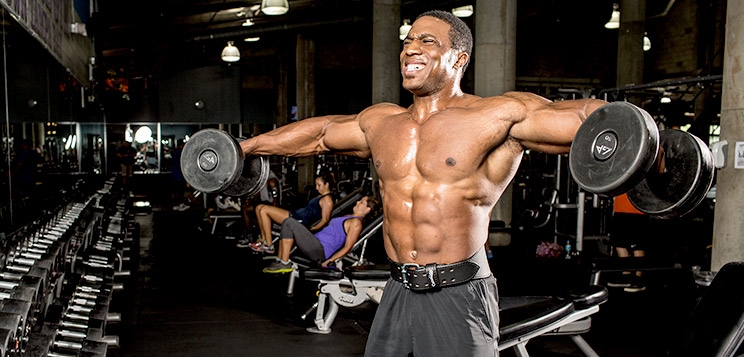In order to achieve your best body, you must optimize all three of these advanced methods for rapid muscle growth.
By: Tim Ernst – Founder of F40 Fat Loss Formula
A 2010 paper in the Journal of Strength & Conditioning Research by Brad Schoenfeld identified these three mechanisms of rapid muscle growth as – mechanical tension, metabolic stress, and muscle damage
Most guys who do not know how to optimize all three of these factors (mechanical tension, metabolic stress, and muscle damage) to muscle growth, end up spinning their wheels and become frustrated as to why they look the same month after month, year after year.
The fact is, muscle needs stimulation to grow. If you don’t expose your muscle to stress, there’s no driving force for muscle to grow.
EDITORS NOTE: If you're looking to get bigger or put on more size, here's how to gain muscle and put on 10 pounds in 30 days with this free muscle gain calculator...=> Click Here For Your Free Muscle Building Calculator
Rapid Muscle Method #1 Optimize Metabolic Stress By NOT Counting Reps
When it comes to building muscle via metabolic stress, performance has very little to do with it. Training with the proper load for the correct TUT (Time Under Tension) will get you your muscle gains.
Metabolic stress is brought about by several factors, including:
- The lack of oxygen supply in the muscles due to the trapping of blood.
- The build-up of metabolic byproducts such as lactic acid
- The cell swelling or “pump” of the muscles
Metabolic stress is BEST produced when you keep the weight moving with a continuous cadence while squeezing your muscles like they owe you cash.
Not cranking out one extra rep than the previous week.
I want you to think about the feeling you get when you know you’re really targeting your muscle – that burning sensation you create and the pump you feel.
These are the two mechanisms that fall under metabolic stress.
The best way to optimize metabolic stress is to STOP counting reps. Specialization programs are a good example of timing your sets rather than counting reps which in turn will literally FORCE your muscles into rapid growth.
Why?
Typical bodybuilding programs recommend 6-8 or 8-12 reps which results in sets that hardly last 20-25 seconds, which is great for muscle strength but not for muscle size. Studies have shown that in order to produce and maximize metabolic stress you need at least 30-40 seconds of TUT (Time Under Tension)
Time Under Tension has the greatest effect when muscle are stretched while being activated or flexed.
High tension through a full range of motion is very effective at producing metabolic stress due to the prolonged muscle contractions, which leaves no time for blood to escape the muscles and ultimately causes the pump effect.
So constant tension and greater TUT are very effective at inducing metabolic stress
Low-rep training alone is not sufficient for maximal gains. You must incorporate “timed sets” of 40 seconds or more in your training.
Focusing on “timed sets” rather than “counting reps” is what produces metabolic stress leading you towards rapid muscle growth.
Exercises like bicep curls, leg extensions, leg curls, rope tricep extensions, the pec dec, shoulder lateral raises are very valuable. When the sets are “timed” with short rest periods and multiple sets, they can produce a skin-splitting pump.
Rapid Muscle Method #2 Mechanical Tension By Implementing Rest Pause Sets
The key to steady growth without plateaus is to force your neuromuscular system to adapt to a continuously changing set of stimuli.
After constantly hammering your muscles with high volume and metabolic stress, transitioning into a phase with much lower volume allows your body to utilize more incoming calories to support muscle size and growth rather than having them burned off as energy.
Now, we don’t just want to move the heaviest weights possible.
After you pass a certain percentage of maximum strength you lose tension in the target muscle as your body simply uses whatever it needs (other muscles and connective tissues) to move the weight by any means possible, which generally results in a lot of undue joint stress.
After all, what’s better than lifting a heavy weight and producing lots of mechanical tension?
Lifting that weight for more overall reps, thus producing even more tension over the course of the workout, and forcing your body to get bigger and stronger.
How do we do that?
Rest Pause Sets.

- Perform a set at your 90% max weight as you would with your given 6-10 rep weight. Set the weight down.
- Take 15-20 seconds rest, pick the weight back up, and rep out 4-6 reps.
- Repeat step two 3 more times
With this type of training, rest pause sets will not only get you serious results as far as muscle size, but improve the efficiency of your neuro-muscular communication, making it easier to continue muscle growth faster than other guys who don’t know this method.
Exercises that place the greatest tension when in the stretched position) are best suited for creating mechanical tension for hypertrophy.
So exercises like, overhead cable triceps extensions, incline bench dumbbell curls, pullovers, dumbbell chest flies, lunges and Romanian deadlifts are valuable.
Rapid Muscle Method #3 Muscle Damage With DRTS
Employing slow negatives, at a lot of angles with a decent amount of volume, creates muscle damage.
Super-sets and GIANT sets such as DRTS (found in 180 Muscle) are a great way to create muscle damage in the quickest time possible.
Super-sets and DRTS sets are also great if you are looking to go into a cutting phase.
This type of workout will deplete glycogen levels within the muscle resulting in muscle building while losing fat.
You’ll know that you’ve created muscle damage when you experience soreness approximately two days following a challenging bout of exercise.
By this time your soreness will likely reach it’s peak, and this soreness is a result of muscular damage.
Damage to muscle tissue creates a temporary inflammatory response and releases the necessary signals for muscle growth.
Another great way to produce muscle damage is to accentuate the eccentric portion of an exercise by lowering the weight more slowly and under control with each repetition.
But just as in the case of training for metabolic stress like we talked about at the beginning of this article, exercise selection tends to be largely ignored when training to optimize muscle damage.
You want to choose exercises that activate muscles while they’re stretched to long muscle lengths, so think of exercises like dumbbell flyes, cable lateral raises, dumbbell pullovers, incline curls, overhead extensions, and Romanian deadlifts.
What’s Next?
As you probably know or at some point you’ve been told that the best way to build muscle is by training each muscle group a different day of the week…
- Chest on Monday…
- Legs on Tuesday…
- Back on Wednesday…
- And so on. Or…
Maybe you’ve tried the double-up split where you train upper body one day, then lower body the next.
However, there’s something you need to know….
These workouts are silently chipping away at your testosterone levels and causing you to leave massive muscle building results on the table…
Yes you read that right…
But don’t worry, it doesn’t have to be this way. Because…
Believe it or not, there’s one type of muscle building routine that’s BEST for your male hormones and packing on some serious size at the exact same time.
And to prove it, here is..
=> The Mother Of All Muscle Building Routines
References
- Schoenfeld, B. J. (2010). The mechanisms of muscle hypertrophy and their application to resistance training. The Journal of Strength & Conditioning Research, 24(10), 2857-2872
- Pinto, R., Cadore, E., Correa, C., da Silva, B., Alberton, C., Lima, C., & de Moraes, A. (2013). Relationship between workload and neuromuscular activity in the bench press exercise. Medicina Sportiva, 17(1), 1-6.




